Page 444 of 668
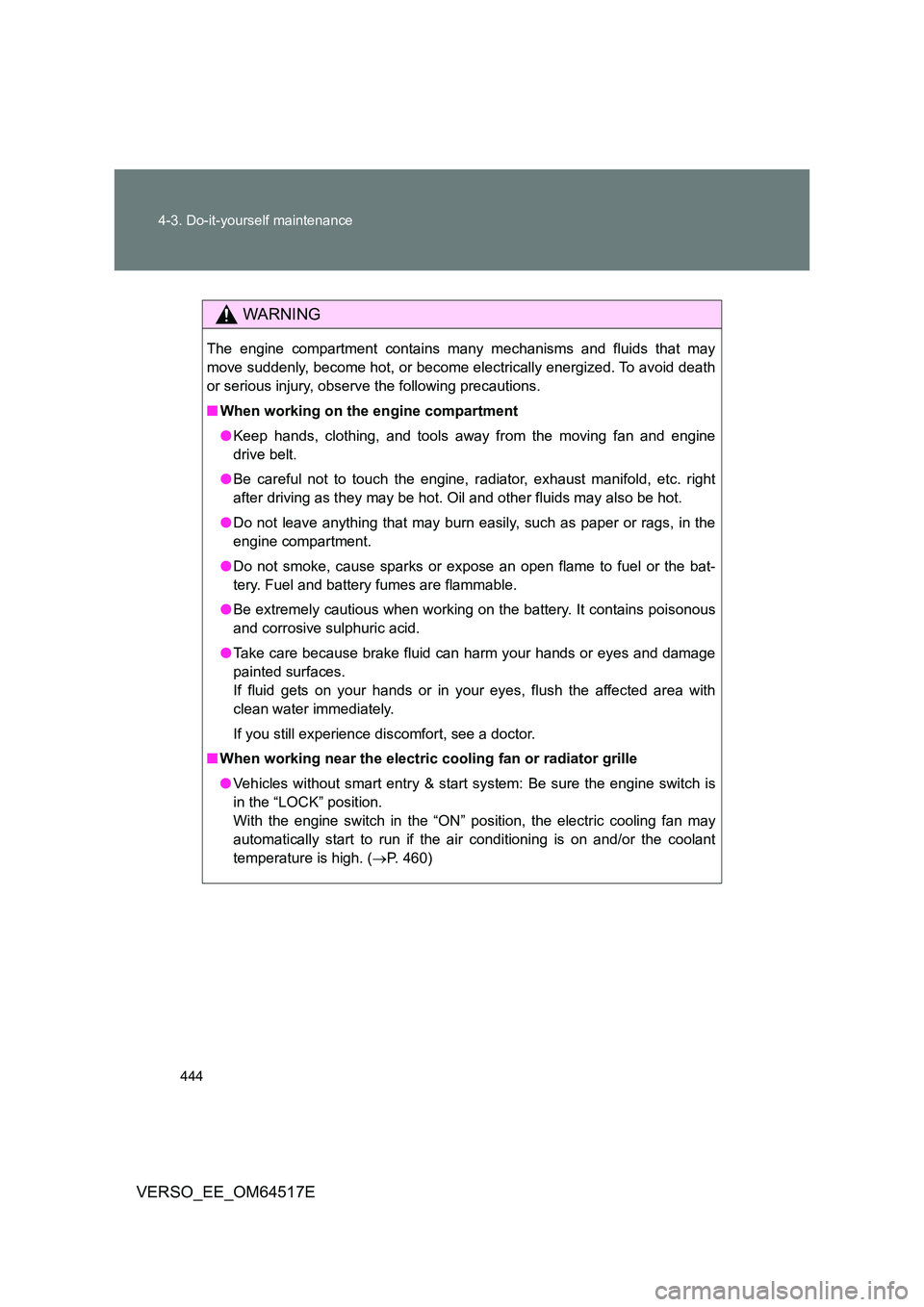
444
4-3. Do-it-yourself maintenance
VERSO_EE_OM64517E
WARNING
The engine compartment contains many mechanisms and fluids that may
move suddenly, become hot, or become electrically energized. To avoid death
or serious injury, observe the following precautions.
■ When working on the engine compartment
● Keep hands, clothing, and tools away from the moving fan and engine
drive belt.
● Be careful not to touch the engine, radiator, exhaust manifold, etc. right
after driving as they may be hot. Oil and other fluids may also be hot.
● Do not leave anything that may burn easily, such as paper or rags, in the
engine compartment.
● Do not smoke, cause sparks or expose an open flame to fuel or the bat-
tery. Fuel and battery fumes are flammable.
● Be extremely cautious when working on the battery. It contains poisonous
and corrosive sulphuric acid.
● Take care because brake fluid can harm your hands or eyes and damage
painted surfaces.
If fluid gets on your hands or in your eyes, flush the affected area with
clean water immediately.
If you still experience discomfort, see a doctor.
■ When working near the electric cooling fan or radiator grille
● Vehicles without smart entry & start system: Be sure the engine switch is
in the “LOCK” position.
With the engine switch in the “ON” position, the electric cooling fan may
automatically start to run if the air conditioning is on and/or the coolant
temperature is high. ( P. 460)
Page 477 of 668

477
4-3. Do-it-yourself maintenance
4
Maintenance and care
VERSO_EE_OM64517E
Vehicles sold in Serbia
WARNING
■ When inspecting or replacing tires
Observe the following precautions to prevent accidents.
Failure to do so may cause damage to parts of the drive train, as well as
dangerous handling characteristics, which may lead to an accident resulting
in death or serious injury.
● Do not mix tires of different makes, models or tread patterns.
Also, do not mix tires of remarkably different treadwear.
● Do not use tire sizes other than those recommended by Toyota.
● Do not mix differently constructed tires (radial, bias-belted or bias-ply
tires).
● Do not mix summer, all season and winter tires.
● Do not use tires that have been used on another vehicle.
Do not use tires if you do not know how they were used previously.
■ When initializing the tire pressure warning system (if equipped)
Do not operate the tire pressure warning reset switch without first adjusting
the tire inflation pressure to the specified level. Otherwise, the tire pressure
warning light may not come on even if the tire inflation pressure is low, or it
may come on when the tire inflation pressure is actually normal.
Page 543 of 668
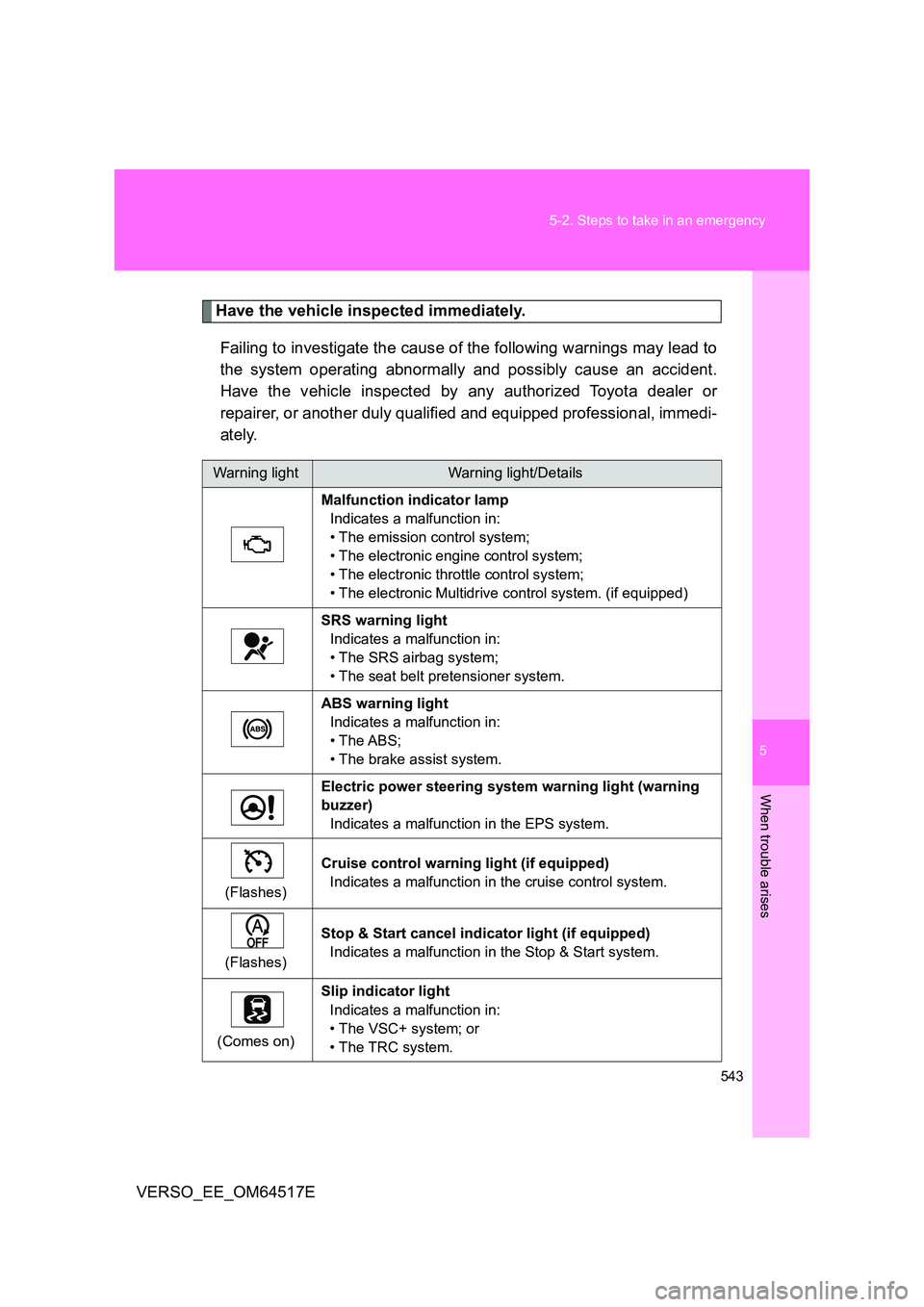
5
543
5-2. Steps to take in an emergency
When trouble arises
VERSO_EE_OM64517E
Have the vehicle inspected immediately.
Failing to investigate the cause of the following warnings may lead to
the system operating abnormally and possibly cause an accident.
Have the vehicle inspected by any authorized Toyota dealer or
repairer, or another duly qualified and equipped professional, immedi-
ately.
Warning lightWarning light/Details
Malfunction indicator lamp
Indicates a malfunction in:
• The emission control system;
• The electronic engine control system;
• The electronic throttle control system;
• The electronic Multidrive control system. (if equipped)
SRS warning light
Indicates a malfunction in:
• The SRS airbag system;
• The seat belt pretensioner system.
ABS warning light
Indicates a malfunction in:
• The ABS;
• The brake assist system.
Electric power steering system warning light (warning
buzzer)
Indicates a malfunction in the EPS system.
(Flashes)
Cruise control warning light (if equipped)
Indicates a malfunction in the cruise control system.
(Flashes)
Stop & Start cancel indicat or light (if equipped)
Indicates a malfunction in the Stop & Start system.
(Comes on)
Slip indicator light
Indicates a malfunction in:
• The VSC+ system; or
• The TRC system.
Page 547 of 668
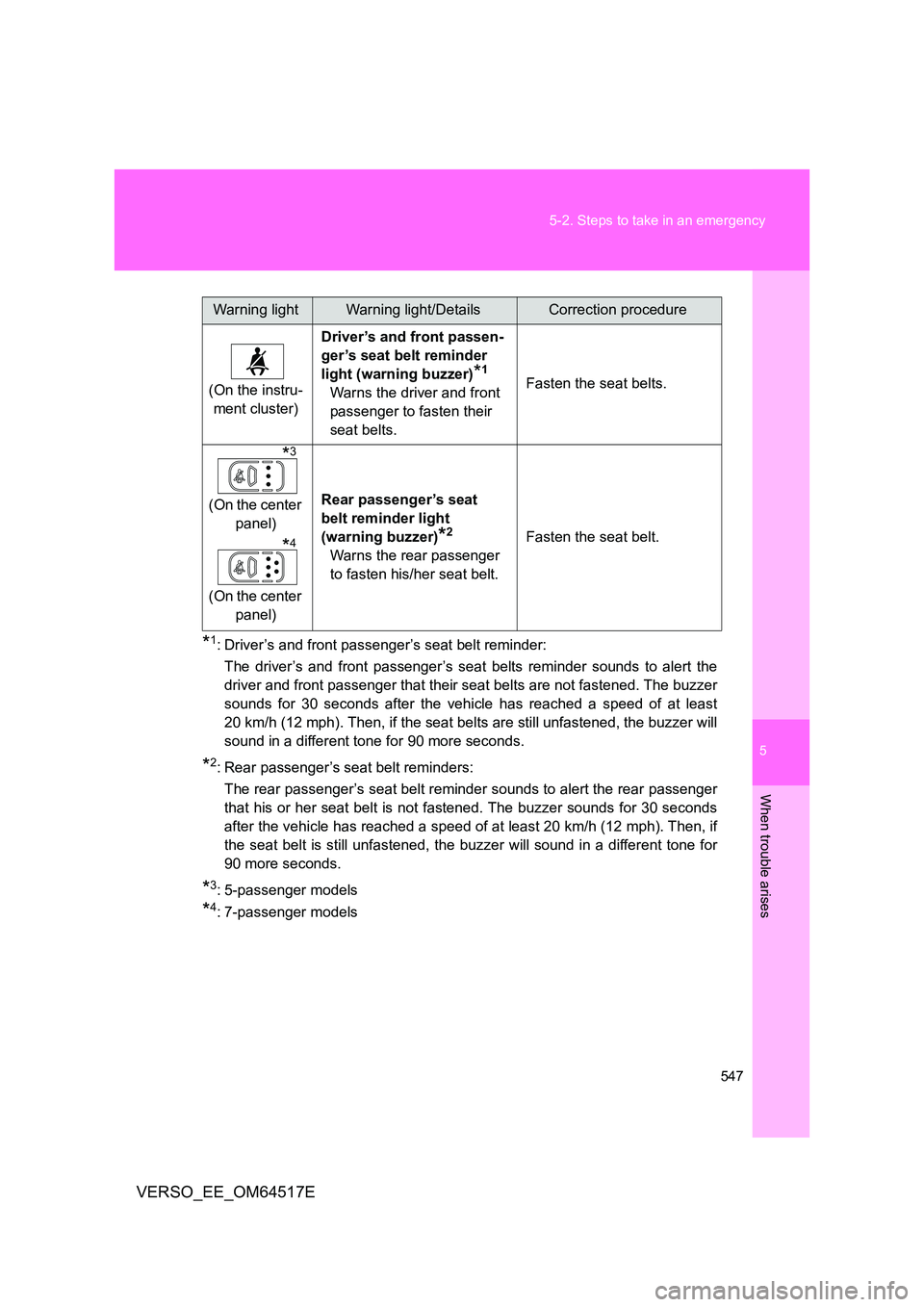
5
547
5-2. Steps to take in an emergency
When trouble arises
VERSO_EE_OM64517E
*1: Driver’s and front passenger’s seat belt reminder:
The driver’s and front passenger’s seat belts reminder sounds to alert the
driver and front passenger that their seat belts are not fastened. The buzzer
sounds for 30 seconds after the vehicle has reached a speed of at least
20 km/h (12 mph). Then, if the seat belts are still unfastened, the buzzer will
sound in a different tone for 90 more seconds.
*2: Rear passenger’s seat belt reminders:
The rear passenger’s seat belt reminder sounds to alert the rear passenger
that his or her seat belt is not fastened. The buzzer sounds for 30 seconds
after the vehicle has reached a speed of at least 20 km/h (12 mph). Then, if
the seat belt is still unfastened, the buzzer will sound in a different tone for
90 more seconds.
*3: 5-passenger models
*4: 7-passenger models
(On the instru-
ment cluster)
Driver’s and front passen-
ger’s seat belt reminder
light (warning buzzer)*1
Warns the driver and front
passenger to fasten their
seat belts.
Fasten the seat belts.
(On the center
panel)
(On the center
panel)
Rear passenger’s seat
belt reminder light
(warning buzzer)*2
Warns the rear passenger
to fasten his/her seat belt.
Fasten the seat belt.
Warning lightWarning light/DetailsCorrection procedure
*4
*3
Page 548 of 668

548
5-2. Steps to take in an emergency
VERSO_EE_OM64517E
■ Front passenger detection sensor and passenger seat belt reminder
● If luggage is placed on the front passenger seat, the front passenger
detection sensor may cause the warning light to flash, even if a passen-
ger is not sitting in the seat.
● If a cushion is placed on the seat, the sensor may not detect a passen-
ger, and the warning light may not operate properly.
■ When the tire pressure warning light comes on (vehicles with a tire
pressure warning light system)
Inspect the appearance of the tire to check that the tire is not punctured.
If the tire is punctured: P. 566, 583
If the tire is not punctured:
Carry out the following procedure after the tire temperature has lowered suffi-
ciently.
● Check the tire inflation pressure and adjust to the appropriate level.
● If the warning light does not go out even after several minutes, check that
the tire inflation pressure is at the specified level and carry out initialization.
The warning light may come on again if the above operations are conducted
without first allowing the tire temperature to lower sufficiently.
■The tire pressure warning light may come on due to natural causes
(vehicles with a tire pr essure warning light system)
The tire pressure warning light may come on due to natural causes such as
natural air leaks and tire inflation pressure changes caused by temperature.
In this case, adjusting the tire inflation pressure will turn off the warning light
(after a few minutes).
■ When a tire is replaced with a spare tire (vehicles with a tire pressure
warning light system)
The spare tire is not equipped with a tire pressure warning valve and trans-
mitter. If a tire goes flat, the tire pressure warning light will not turn off even
though the flat tire has been replaced with the spare tire. Replace the spare
tire with the repaired tire and adjust the tire inflation pressure. The tire pres-
sure warning light will go off after a few minutes.
Page 612 of 668
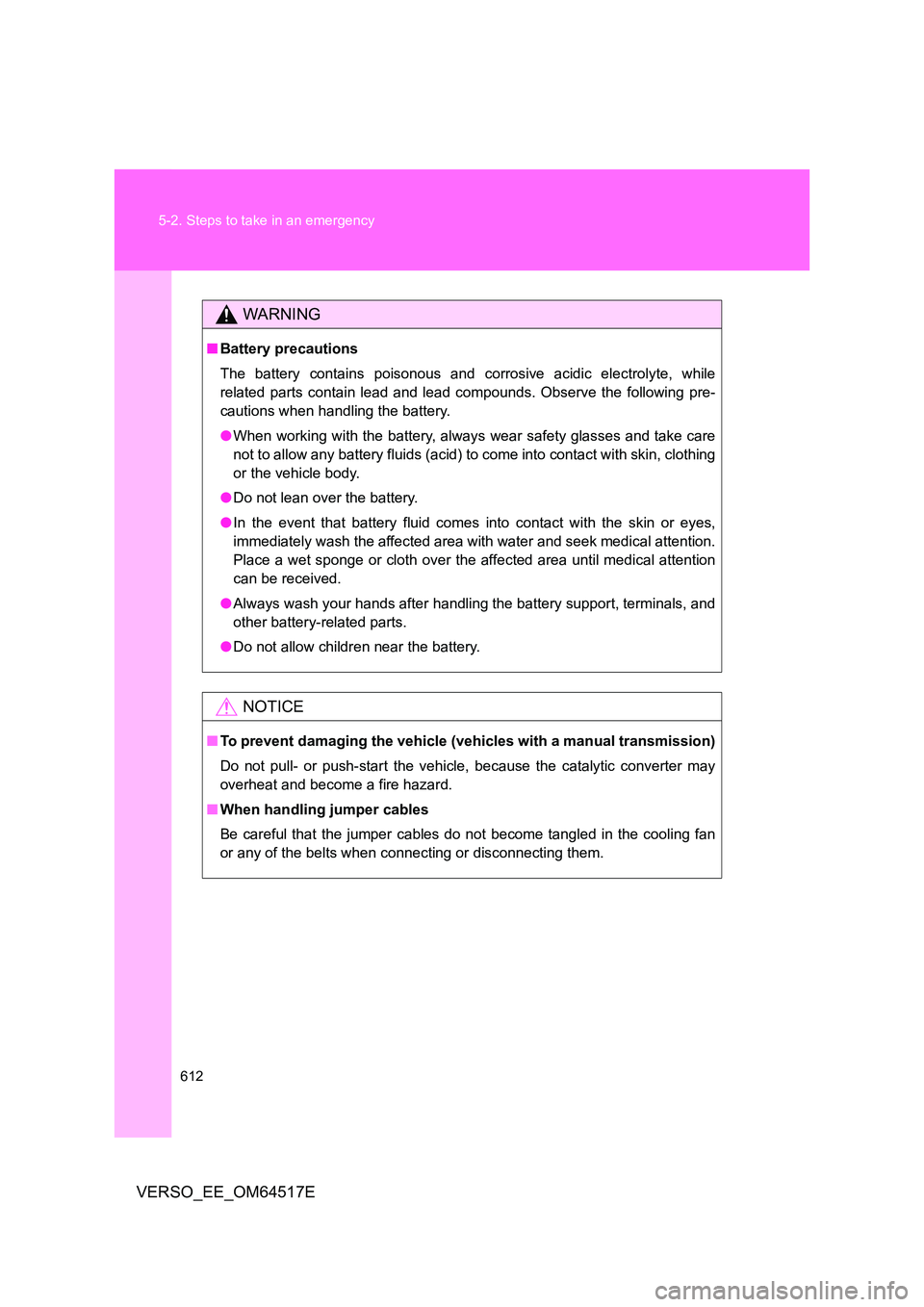
612
5-2. Steps to take in an emergency
VERSO_EE_OM64517E
WARNING
■ Battery precautions
The battery contains poisonous and corrosive acidic electrolyte, while
related parts contain lead and lead compounds. Observe the following pre-
cautions when handling the battery.
● When working with the battery, always wear safety glasses and take care
not to allow any battery fluids (acid) to come into contact with skin, clothing
or the vehicle body.
● Do not lean over the battery.
● In the event that battery fluid comes into contact with the skin or eyes,
immediately wash the affected area with water and seek medical attention.
Place a wet sponge or cloth over the affected area until medical attention
can be received.
● Always wash your hands after handling the battery support, terminals, and
other battery-related parts.
● Do not allow children near the battery.
NOTICE
■To prevent damaging the vehicle (vehicles with a manual transmission)
Do not pull- or push-start the vehicle, because the catalytic converter may
overheat and become a fire hazard.
■ When handling jumper cables
Be careful that the jumper cables do not become tangled in the cooling fan
or any of the belts when c onnecting or disconnecting them.
Page 615 of 668
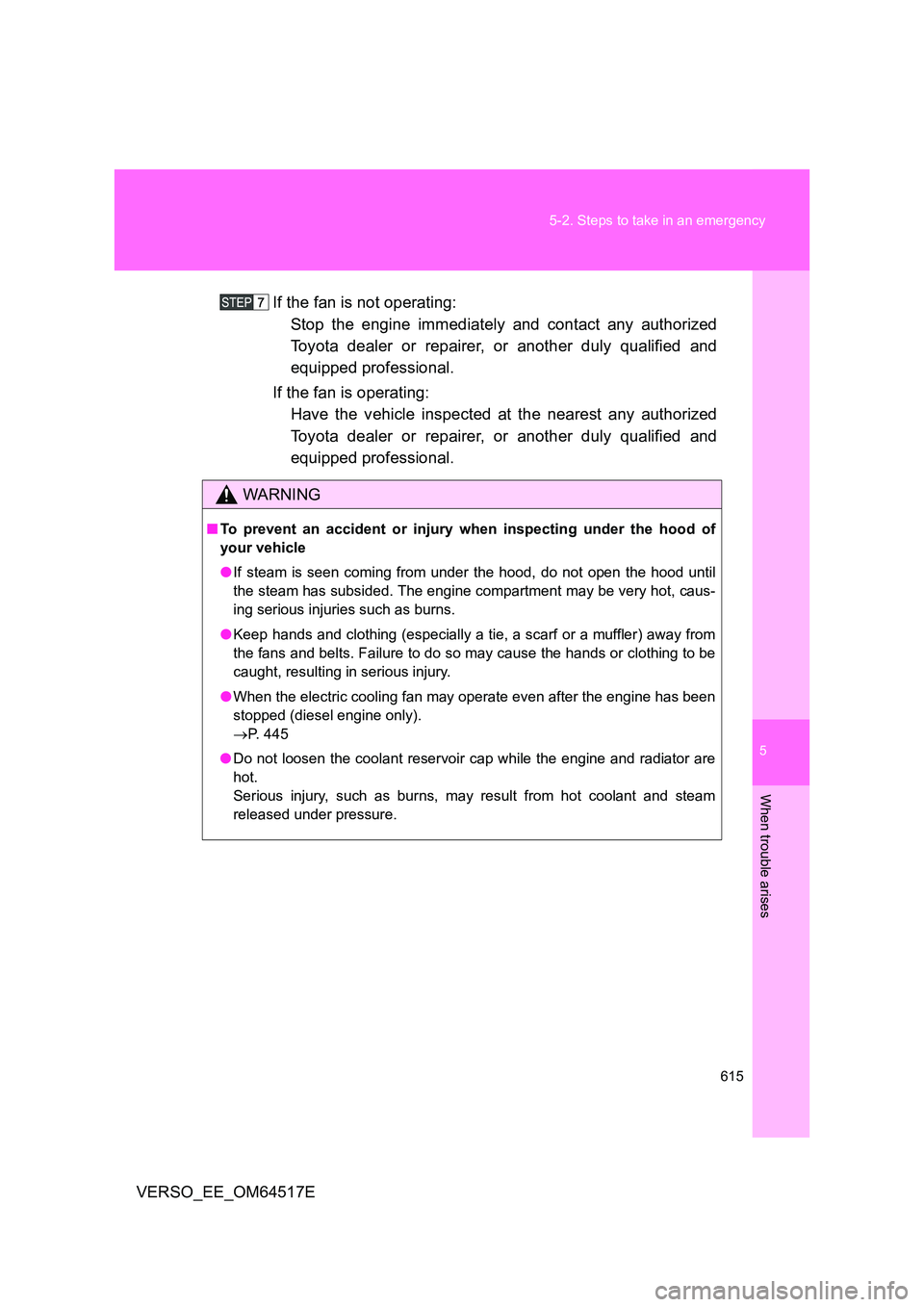
5
615
5-2. Steps to take in an emergency
When trouble arises
VERSO_EE_OM64517E
If the fan is not operating:
Stop the engine immediately and contact any authorized
Toyota dealer or repairer, or another duly qualified and
equipped professional.
If the fan is operating:
Have the vehicle inspected at the nearest any authorized
Toyota dealer or repairer, or another duly qualified and
equipped professional.
WARNING
■ To prevent an accident or injury when inspecting under the hood of
your vehicle
● If steam is seen coming from under the hood, do not open the hood until
the steam has subsided. The engine compartment may be very hot, caus-
ing serious injuries such as burns.
● Keep hands and clothing (especially a tie, a scarf or a muffler) away from
the fans and belts. Failure to do so may cause the hands or clothing to be
caught, resulting in serious injury.
● When the electric cooling fan may operate even after the engine has been
stopped (diesel engine only).
P. 445
● Do not loosen the coolant reservoir cap while the engine and radiator are
hot.
Serious injury, such as burns, may result from hot coolant and steam
released under pressure.
Page 626 of 668
626
6-1. Specifications
VERSO_EE_OM64517E
Engine
Gasoline engine
Model 1ZR-FAE, 2ZR-FAE
Type 4-cylinder in line, 4-cycle, gasoline
Bore and stroke
1ZR-FAE engine
80.5 78.5 mm (3.17 3.09 in.)
2ZR-FAE engine
80.5 88.3 mm (3.17 3.48 in.)
Displacement
1ZR-FAE engine
1598 cm3 (97.5 cu. in.)
2ZR-FAE engine
1798 cm3 (109.7 cu. in.)
Valve clearance
(Engine cold) Automatic adjustment
Drive belt tension
Vehicles without air
conditioning system
Vehicles with air
conditioning system
7.6 10.0 mm (0.30 0.39 in.)*
*: Drive belt deflection with 98 N (10 kgf, 22 lbf)
thumb force (used belt)
Crankshaft
Generator
Water pump
Crankshaft
Generator
Water pump
Air conditioning compressor